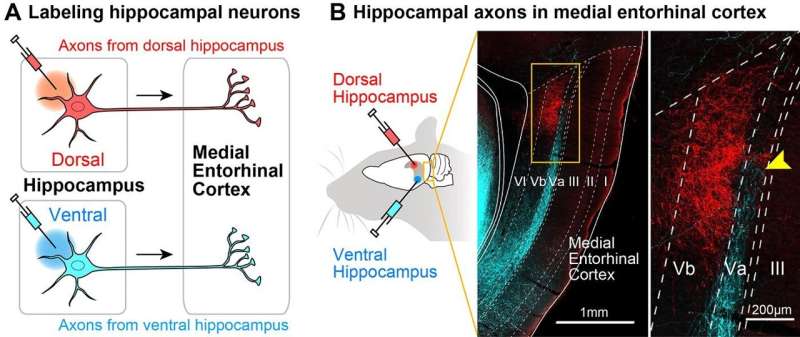Previous (A) and updated circuit diagram (B) of the circuit from the hippocampus to the medial entorhinal cortex. We found that the ventral hippocampus efficiently sends out the information to the neocortex via the medial entorhinal cortex (blue arrows in B). Credit: Shinya Ohara et al.
Wanting to better understand how the brain forms and stores long-term memory, an international team of scientists undertook a study of the brain's circuits. Their work sheds new light on the way the circuits in the brain work, providing fresh insights into the brain's long-term memory formation and storage.
Their work was published in the journal Cell Reports on January 20, 2023.
"In order to understand how we form memory, store memory, and recall memory, it is essential to unravel the complicated wiring of the memory circuits composed by the hippocampus and the entorhinal cortex," said Shinya Ohara, an assistant professor in the Graduate School of Life Sciences at Tohoku University.
The hippocampus is the region of the brain that is primarily related to memory. The entorhinal cortex is the area of the brain that serves as a kind of network hub for navigation, memory, and perception of time. It is part of the brain's hippocampal memory system and serves as a gateway between the hippocampal formation and the neocortex, that part of the brain that controls higher brain function.
Scientists have long understood the general organization of this hippocampal and entorhinal circuit. In the early 1990s, scientists identified the basic wiring of this brain circuit. With these earlier studies, scientists thought that the hippocampus and the entorhinal cortex were connected by parallel identical circuits. However, the research team's findings bring new understanding of the memory circuits in the hippocampus and entorhinal cortex.
The circuit was examined by labeling the axons of hippocampal neurons (A). Ventral hippocampal neurons massively send their axons (cyan) to the medial entorhinal cortex which reaches the dorsal portion of layer Va (B, yellow arrowhead). Credit: Shinya Ohara et al.
The team conducted their study using anterograde tracing and in vitro electrophysiology in rodents. They discovered that the ventral hippocampus efficiently sends out information to the neocortex via the medial entorhinal cortex. Their study revealed that the ventral hippocampus—that part of the hippocampus related to stress and emotion—sends information to the medial entorhinal cortex layer Va neurons.
The entorhinal cortex consists of six layers—this Va layer is one of the deep layers. When this information is received in the entorhinal cortex, it processes the information to the neocortex. This connectivity indicates that the ventral hippocampus controls the signal flow from the hippocampus to the neocortex, which supports long-term memory formation and storage.
Since the ventral hippocampus is well known for processing emotional information, the research team hypothesizes that this circuit may play an important role in memorizing emotional events. "For example, in our daily lives, we remember happy events or sad events very well. The neural mechanism of how the emotional events are memorized is largely unknown. The circuit which we identified in this study may play an important role in processing such emotional memories," said Ohara.
Looking ahead, the team's next step is to test their hypothesis. They plan to selectively inactivate this pathway of the ventral hippocampal to medial entorhinal cortex layer Va while the animal performs a memory task. Generally, animals will approach a place where they experienced happy events while avoiding the places that caused bad memories. "We think that the animal will not be able to form such emotional memory when the ventral hippocampal-medial entorhinal cortex circuit is inactivated," said Ohara.
More information: Shinya Ohara et al, Hippocampal-medial entorhinal circuit is differently organized along the dorsoventral axis in rodents, Cell Reports (2023). DOI: 10.1016/j.celrep.2023.112001
Journal information: Cell Reports
Provided by Tohoku University

























